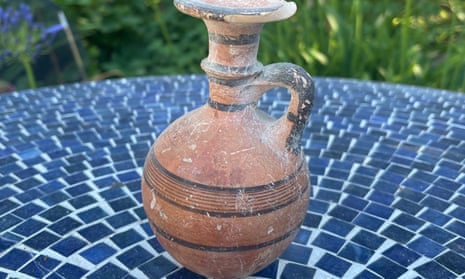An American man has returned 19 antiquities to the four countries they came from after reading reports in the Guardian about the repatriation of looted antiquities.
John Gomperts, who lives in Washington, realised that the ancient pieces worth up to £80,000 – including two seventh- and eighth-century BC Cypriot vases – that he had inherited from his grandmother could have come from illicit excavations because they have no collecting history.
He wanted to do the right thing legally and ethically by returning the items to Italy, Greece, Cyprus and Pakistan respectively. After an agreement with his two siblings, he has returned them.
He said: “It seemed like the right thing to do … I read stories on repatriation and I thought: we have these pieces that are 2,500 years old from other countries; we should explore whether we can give them back.”
But with no idea how to repatriate antiquities, he was initially worried that he could be in trouble with the authorities for having potentially looted the artefacts in his possession.
In those Guardian reports, he noticed that Prof Christos Tsirogiannis, a former senior field archaeologist at the University of Cambridge and a specialist in antiquities and trafficking networks, had been quoted, and so he reached out to him for advice.
Based in Cambridge, Tsirogiannis is the head of illicit antiquities trafficking research for the Unesco Chair on Threats to Cultural Heritage at the Ionian University in Corfu, Greece. Over 15 years, he has identified more than 1,600 looted artefacts within auction houses, commercial galleries, private collections and museums, alerting police authorities and governments and playing a significant role in repatriating antiquities.
They include an ancient Greek bronze horse, which Sotheby’s in New York was due to sell in 2018 until Tsirogiannis notified the authorities of its links to a disgraced British antiquities dealer. In 2020, Sotheby’s lost its legal challenge and Greece’s culture minister hailed the court’s ruling as a significant victory for countries fighting to reclaim antiquities.
Tsirogiannis said Gomperts was setting an extraordinary example. “He reached out to me, which is a first for an owner of unprovenanced antiquities, asking for advice to do the right thing,” he said. “It’s a wonderful case of a person who did so because he had read the Guardian articles. It shows how such publications are raising awareness and bringing actual results. He sent me photos of the antiquities, which were clearly authentic.”
He identified each antiquity, indicating the country to which it should be returned. “Twelve objects belong to Greece, four to Italy, one to Pakistan, and two to Cyprus. I advised him to give them back,” he said.
“I told him: ‘If you follow my advice then you will have no problems and also become an example for other people to follow. You wrap them in a box for each country and go to their embassies. Please use my name – this will protect you. The most honest way is the straightforward way.’”
The items included two fourth-century BC ceramic plates decorated with acrobats by south Italian painters – an “unusual subject”, he said – a lebes gamikos, a fourth-century BC vase used in ancient Greek marriage ceremonies, and a stone relief fragment showing the followers of Buddha, carved in the second or third century BC.

Gomperts is an adviser to non-profit organisations. His German-Dutch grandmother Gisela Schneider-Herrmann died in 1992, aged 98. She was active in various excavations, particularly in Italy and Greece in the 1950s and 1960s, and published scholarly papers.
Her grandson said: “I have no idea how she actually acquired these objects. She was a prim and proper person. But there were different norms of the day. These objects were her obsession, her entire existence.”
A couple of the objects came with receipts, but Tsirogiannis realised their links to known Greek dealers of illicit antiquities in the 1950s and 1960s. “So this alerted me even more for him to repatriate them immediately,” he said.
Gomperts said: “I knocked on embassy doors and said ‘I have a delivery’. I said: ‘I want to repatriate these things.’”
The countries showed their appreciation, with notes of thanks to Gomperts and Tsirogiannis.
Tsirogiannis said: “This case will show others who want to do something that they can be protected when doing the right thing.”
